Turtle Beach was a professional audio company based in New York and was started back in 1985 by Roy Smith and Robert Hoke. Turtle Beach Systems achieved prominence in the PC multimedia industry with its award-winning sound cards that pioneered PC-based hard-disk recording, multi-channel PC audio playback, and DSP (Digital Signal Processing) technology.
The vast majority of cards from Turtle Beach are *NOT* compatible with other PC sound standards such as Ad Lib or Sound Blaster (the exception being the Tropez range and the Monte Carlo range), so if you are looking for a DOS gaming sound card look elsewhere. Having said that, for General MIDI, these are some of the very best cards you can buy, with excellent low noise.
In 1996, Turtle Beach was sold by ICS to Voyetra Technologies.
Today they still exist, though they've moved into high-end gaming headsets and other gaming accessories for PC and consoles. Their website is here.
For brevity, here's a list of the various generations of Turtle Beach card (the ones in bold indicate the premium MultiSound series; those not in bold indicate their more budget-oriented cards):
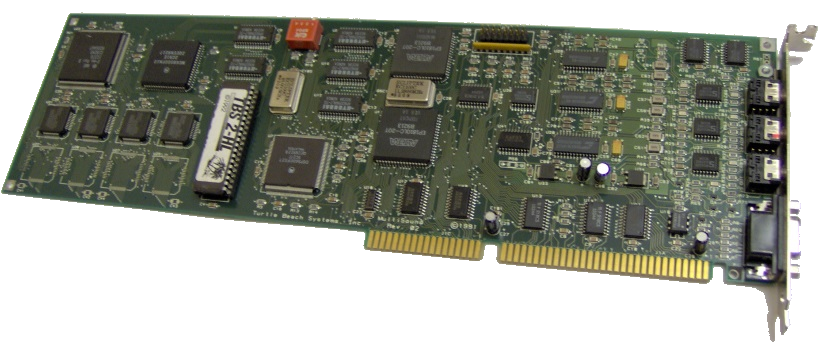 MultiSound [Classic] MultiSound [Classic] 
Introduced: 1992
Synthesizer: E-mu Proteus 1/XR
Chipset/DSP: Motorola 56001
Memory: 4 MB ROM
Bus: 16-bit ISA
CD-ROM Interface: None
Jacks: Line Out, Mic, Speaker
Wavetable Header: None
Plug & Play: No
DAC: 18-bit
Signal to Noise Ratio: -82.4 dB
FCC ID: JMN-TBS-MSND-PC00
Known Board Revisions: 02
Original Purchase Price: $995 (card only), $1,795 (MPC upgrade kit with SCSI controller and internal Toshiba CD-ROM drive), $1,895 (same but external CD-ROM drive), $499 (Nov 1993, card only)
The MultiSound 16-bit sound card won nearly every major editorial award in its category – PC Magazine Editor’s Choice, Windows® 100, InfoWorld Recommended Product, PC Computing Top 200, Windows User Best of Breed and Best Buy, Electronic Musician’s Editor’s Choice, and others. Rich Heimlich said "Every magazine called this the best business audio card on the market year-in and year-out. The only problem is, there's no such thing as a "business audio" market and never was. Now if only PC Magazine would
figure that out and stop reviewing things from that perspective.". He scored the card 10 out of 10 for digital quality and 9.5 out of 10 for music quality.
When first released the card was simply called "MultiSound". When Turtle Beach launched their second generation of cards (Tahiti, Rio, and Monterey) a few years later, they rebranded this first-gen the "MultiSound Classic".
The first generation MultiSound series used a Motorola 56001 DSP (Digital Signal Processor) chip clocked at 40 MHz and able to process 10.5 million instructions per second (10.5 MIPS). It supported 8- or 16-bit recording at up to 44.1 kHz stereo sampling rates.
The Proteus 1/XR synthesizer from E-mu was a close relative of the original WaveBlaster from Creative Labs, both of which appear to be similar to E-mu's "SoundEngine". The onboard sample ROM had 384 sound presets using 126 instruments. It could output up to 32 simultaneous voices.
Verdict: The Multisound series, whilst having some DOS compatibility are really only useful as MIDI cards (they were never designed to be used with games, DOS or to replace an Ad Lib or Sound Blaster) - The DAC cannot be set to work on an I/O range that works with Sound Blaster. The card comes with an onboard ROM bank for wavetable synth output, but you cannot change the card to use a wavetable daughterboard from DOS, so you are stuck with the onboard synth for DOS use. For Windows, it is a more usable card with excellent audio quality for MIDI output. The card comes with two memory slots to allow you to load your own samples into RAM.
General MIDI audio quality is very good.
|
.png) MultiSound Tahiti MultiSound Tahiti 
Introduced: 1994
FM Synthesizer: None
Chipset/DSP: Motorola 56001
Memory: ?
Bus: 16-bit ISA
CD-ROM Interfaces: None
Jacks: Line Out, Mic, Speaker
Wavetable Header: None
Plug & Play: No
Price when New: $259 USD
Known Board Revisions: 5.2
The Tahiti is part of the second generation of MultiSound sound cards from Turtle Beach. It uses a Motorola 56001 DSP chip like MultiSound does, but unlike some other MultiSounds, Tahiti does not come with an onboard wavetable, instead simply providing a header for connection to a General MIDI (GM) wavetable daughterboard.
A lot had happened from the launch of the first MultiSound in 1991/1992 in the world of synthesizers. The E-mu Proteus 1/XR used on the first-gen cards had been removed from sale to OEMs when Creative bought-out E-mu in 1993, leaving Turtle Beach without a synthesizer chipset. This pushed Turtle Beach to merge with Integrated Circuit Systems (ICS) where together they developed a new rival synth called ICS WaveFront.
There is a small list of games that directly support Turtle Beach MultiSound.
|
 Rio Rio  
Introduced: 1994
Chipset: ICS WaveFront 2115/2116
Memory: 4 MB Sample ROM, SIPP slot for RAM
Bus: N/A
CD-ROM Interfaces: None
Jacks: N/A
Wavetable Header: N/A
Plug & Play: No
DAC: N/A
Price when New: $139 USD
Known Board Revisions: 2.0, 3.0
The Rio was a wavetable MIDI daughterboard that came with a huge 4 MB ROM onboard for samples. It used the soundfonts from VoiceCrystal (the same as those used by the TB Tropez+, TB Maui and Aztech WaveRider 32).
It was often sold with the Turtle Beach Tahiti sound card as a bundle, which they called Monterey.
The Rio DB is physically very similar to the Creative Labs WaveBlaster CT1900, and is electrically compatible.
Rich Heimlich reviewed the Rio, stating that Rio had a: "Much better sound than the Wave Blaster at a better price. RAM
Sampling and limited effects are a bonus but the RAM sampling is
painfully slow due to the WB interface which is why no other DB's
offer this feature. The Rio is used on the Monterey so it can be
hard to find.". Music quality was scored at 6.5 out of 10.
The ICS WaveFront™ synthesizer chip, ICS2115, was jointly developed by Turtle Beach Systems and Integrated Circuit Systems (hence the ICS prefix in the name) in 1993. The key benefit of ICS WaveFront is that you can load samples and soundfonts into RAM to replace the onboard ROM samples. This can be done using the SETWF utility. Soundfonts for the ICS WaveFront use a proprietary format with a .WFB file extension. This is synonymous [though not compatible] with Creative's .SF2 soundfont format and Dream's .94B format.
ICS WaveFront datasheet |
 MultiSound Monterey MultiSound Monterey  
Introduced: 1994
Synthesizer: (see Rio)
Chipset: ICS WaveFront 2115/2116 (on daughterboard)
DAC:
Memory: 4 MB ROM
Bus: 16-bit ISA
CD-ROM Interfaces: None
Jacks: Line Out, Mic, Speaker
Wavetable Header: Yes
Plug & Play: No
Price when New: $399 USD, $349 (Jun 1994)
Part of the MultiSound second generation, Monterey is the Tahiti card with the Rio daughterboard attached, bundled as an all-in-one purchase.
Since it uses the same Rio daugherboard as you could buy separately, the soundfonts on the Monterey are from VoiceCrystal (the same as those used by the TB Tropez+, TB Maui and Aztech WaveRider 32).
Rich Heimlich said this of the Monterey: "The newer version of the older Multisound. Winning same awards too.
It's less expensive than the original and if it's not used for gaming
the rating goes up to 9. Note that it uses a Rio as the music engine.". Digital quality scored 10 out of 10, while music quality scored 6.5 out of 10. What let it down was support and price (3 and 3.5 out of 10) with an overall score of 5.9 out of 10.
The "Hurricane architecture" that is touted on the box is an electrical design that supposedly circumvents the reliance on the motherboard's DMA, instead handling more on the card itself to relieve the burden on the main CPU (and in so doing vastly improving performance). This lends itself to audio processing of longer pieces rather than short sample playback that games would use.
"Turtle Beach Systems has developed a reputation for professional-quality sound sampling, and its recently released MultiSound Monterey board does not disappoint. At a price of $399, this board provides true studio-quality sound for your authoring and presentation needs. However, it lacks general business features such as voice recognition, text-to-speech synthesis, and a CD-ROM interface.
The MultiSound Monterey samples in 8-bit or 16-bit stereo at rates of 11 kHz to 44 kHz. It includes a 32-voice ICS WaveFront synthesizer and numerous audio effects. Two stereo ports are provided for line input and one for line output. It has a combined MIDI and joystick port but no CD-ROM interface.
Sampling and editing are easily accomplished through the Wave SE application. Like the Sound Blaster, the Monterey does its best sampling at 16-bit resolution. At 44 kHz 16-bit resolution, the Monterey has better sound quality than the AWE32 and produces the most realistic audio quality imaginable. Many evaluators could not distinguish between the original CD and the 44-kHz 16-bit sample. When sampling at 44 kHz 8-bit, we encountered considerable hiss. The AWE32 and Monterey sound very similar at 11 kHz and 22 kHz, though at 11 kHz 8-bit, the Monterey was not as clear as the AWE32. The 22 kHz samples sound good enough for presentations. Stereo panning was accurate, with no audible cross talk.
Wave SE lets you apply effects such as gain adjust, muting, equalization, frequency analysis, cross fading, reverse, invert, DC offset (which can repair improperly recorded sounds), and time compression or expansion. Reverb can be added to the synthesizer through the Rio control panel. We rate high-fidelity audio excellent.
The MultiSound Monterey supports 48 MIDI channels, which gives a lot of flexibility for controlling external MIDI devices. Our listeners found the 32-voice WaveFront
synthesizer to be realistic and useful for presentations. The synthesizer also has the added feature of allowing you to take any .WAV file and use it as a MIDI instrument.
The MultiSound Monterey supports Microsoft ADPCM compression. The Wave SE applications will import SoundStage .SF1, Creative Labs .VOC, SampleVision .SMP, and raw PCM 8- or 16-bit , mono or stereo. It will export Microsoft .WAV, SoundStage .SF1, Creative Labs .VOC, SampleVision .SMP, raw PCM data, Microsoft ADPCM .WAV, and AIFF formats.
"
InfoWorld, July 1994
"There are plenty of low-cost multimedia kits that are just fine for games and business applications. When it comes to multimedia authoring, however, the MultiSound Monterey Multimedia Upgrade Kit ($899) is in a class by itself. Many vendors boast that their cards produce 'CD quality sound', but Turtle Beach's claim is the only one proven by our tests. The Monterey features a high-speed, on-board digital signal processor, which lets you avoid using a DMA channel and lets you record long samples without slowing down your entire system. For serious-minded MIDI and multimedia authoring, it is the only choice."
PC Magazine, January 1995
ICS WaveFront datasheet
|
.png) Maui Maui  
Introduced: Late 1993
Synthesizer: ICS WaveFront 2115/2116
Chipset: Motorola 68SEC000
Bus: 16-bit ISA
DAC:
Memory: 2 MB sample ROM and up to 8.25 MB sample RAM
CD-ROM Interfaces: None
Jacks:
Wavetable Header: None
Plug & Play: No
Price: $140 (at launch), $159 (Nov 1993), $159 (Jun 1994)
Known Board Revisions: 1.0
As per most of the Turtle Beach cards, the Maui is "only" a MIDI card (no Sound Blaster support for example).
Rich Heimlich said, "A solid choice for those wanting a Wave Blaster but not having a WB connector on their existing sound card. Easy to use, inexpensive, fast RAM sampling, but it's all tied to a below-average patch set". It uses the soundfonts from VoiceCrystal (same as those used by the TB Rio, TB Tropez+ and Aztech WaveRider 32).
Alternatively, the user manual states that you can use the Maui as a wavetable daughterboard by connecting its 26-pin header via a ribbon cable to the wavetable header on another sound card, and the Maui will be used for sampled sound instead of your other sound card's onboard samples.
The board uses a Motorola 68000 CPU coupled with an ICS2122 ROM chip, which is 2 MB in capacity.
To use it under DOS you need to run a TSR called SETUPSND.EXE.
ICS WaveFront datasheet |
Tropez / Tropez 32 / Tropez Plus       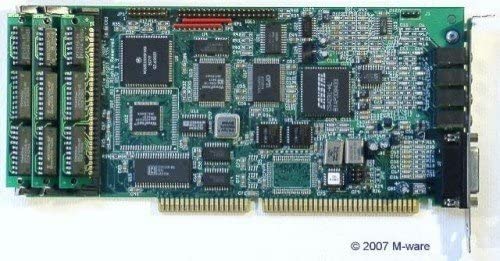
Introduced: Early 1995 (Tropez), 1996 (Tropez 32)
Synthesizer: ICS WaveFront 2115/2116
FM Synth: Yamaha YMF262 OPL3
Chipset: Crystal CS4231 (Tropez, Tropez 32) or CS4232 (Plus)
ROM sizes: 1 MB (OEM cards only?), 2 MB or 4MB (Retail cards only)
Bus: 16-bit ISA
Plug & Play: No
Memory: Up to 8.25 MB sample RAM (Tropez), or up to 12.25 MB (Tropez Plus)
Part Nos: TBS-2000 (Tropez 32), TBS-2001 (Tropez Plus)
FCC IDs: JMN-TBS-2000 (Tropez 32)
Price when New: $249 (retail Tropez), $209 (street Tropez). Later reduced to $199 (Tropez)
Known Board Revisions: 1.3 (Tropez)
An uncommon detour for TB away from professional audio quality, the Tropez series of cards provided Sound Blaster, SB Pro and Windows Sound System (WSS) compatibility coupled with GM wavetable sampled sound.
The heart of the original Tropez was the Crystal Semiconductor CS4231 (also found on the MediaTrix AudioTrix Pro), which at the time was considered to be the most expensive mainstream sound chip available that provided SB and SB Pro compatibility and it had a great SNR (Signal-to-Noise Ratio).
The Tropez32 was the name given to the 1 MB ROM variant.
The Tropez sound card takes advantage of the ICS WaveFront's ability to replace the soundfont held in its onboard ROM with another of your choosing. To achieve this, Tropez has two RAM slots that accept SIPP memory. When you load a new soundfont into its RAM, the card detects this and uses that instead of the onboard ROM samples.
It used the soundfonts from VoiceCrystal (same as those used by the TB Rio, TB Maui and Aztech WaveRider 32).
The Tropez Plus differs from the Tropez in three key areas.
- It supports a larger soundfont RAM area (up to 12.25 MB)
- It comes with a built-in effects processor.
- The Crystal chip used is the newer CS4232 which was their first PnP chip.
"Turtle Beach has always been known for its high-quality wavetable sound cards, but their lack of Sound Blaster compatibility and high price tags made them better suited for musicians than gamers. The $249 Sound Blaster- compatible Tropez changes all that.
The top-rated Tropez produces excellent music; you'll have a hard time distinguishing between your PC and your stereo. And Doom II delivers pulse-pounding audio action that really draws you into the multimedia experience.
Along with great sound, Turtle Beach provides thoughtful touches to help ease installation: an excellent all-in-one manual with a large troubleshooting section, DOS and Windows test utilities, and an option for DOS-only or DOS and Windows installation.
Other extras include an Enhanced IDE CD-ROM interface; RAM expandability to 12MB; Windows recording, playback, and mixer utilities; and a Windows stereo rack program that plays audio CDs and .WAV
or .MID files."
Electronic Entertainment, 1994-1995
Rich Heimlich (user Agrajag27 on Vogons.org, and a widely respected and professional sound card tester) had this to say about the base Tropez: "Currently the best single card solution available. Decent patch set, RAM-able, SB-Pro compatible, fully Windows Sound System compatible. Software needs work so beginners may have difficulty installing it.
It could also be a bit easier to work with on a daily basis."
You do need to install drivers for this to work. Digital audio quality is outstanding, 9 out of 10. Music quality is quite a bit worse. |
Monte Carlo       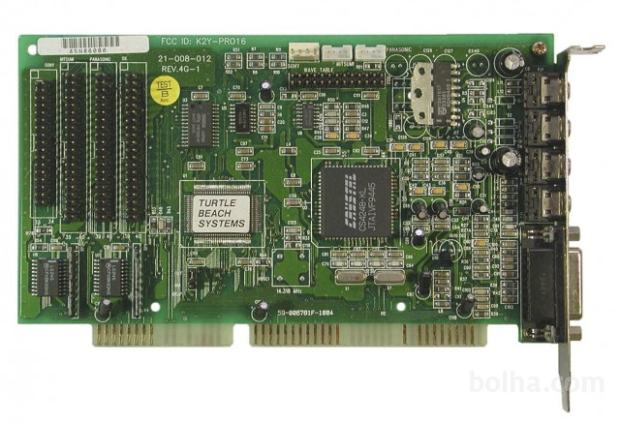
Introduced: Early 1995
FM Synth: Yamaha YMF262 OPL3
Chipset: Crystal CS4248
Bus: 16-bit ISA
Plug & Play: No
Wavetable: Software-based or via Wave Blaster header
Part No: 500.2
FCC IDs: K2Y-PRO16, K33IFISP16R20
Price when New: £145 / $149
Known Board Revisions: 4G-1
Aside from the Tropez series of cards, the Monte Carlo is the only other that provided Sound Blaster, SB Pro and Windows Sound System (WSS) compatibility coupled with GM wavetable sampled sound in software. The Monte Carlo was the budget offering, released alongside their mid-range Tropez in 1995.
The card features an MPU-401-compatible MIDI port (UART only), stereo line-in, stereo line-out, mono mic-in and an amplified speaker-out. It was also pretty unique in providing a header for almost every CD-ROM interface - Sony, Mitsumi, Panasonic and IDE.
Note that in the picture above, the chip under the 'Turtle Beach Systems' sticker is an OPTi 82C929A "MAD 16 Pro".
The Monte Carlo also includes a software-based General MIDI wavetable synthesizer in the form of V-Synth, which can be used to load up 16-bit samples into your PC's main memory. This can use either a 512 KB soundfont or a 2 MB one, and these are in the same .WFB (WaveFront Bank) format used by the Tropez and Maui.
Controlling the software in Windows is achieved via the Sierra Audio Rack software which includes the mixer, a CD player, MIDI player and digital audio player. Also included is Turtle Beach's wave file editor, Stratos which is a notation-based sequencer, and a CD-ROM with 50 demos of games, of which 15 are the full game.
"Turtle Beach MultiSound has undergone some changes and become the Turtle Beach Monterey ($399 list, $329 street), while two new boards have been added: the midrange Turtle Beach Tropez ($249 list, $229 street) and the low-end Turtle Beach Monte Carlo ($149 list, $99 street).
Though the Monterey continues the company's traditional dedication to great sound, the Tropez sacrifices some sonic accuracy for improved compatibility. The Monte Carlo's inferior sound quality makes it a bad bet, even for game players.
If no-compromise sound quality is what you're after, the Monterey is what you want. It doesn't offer Sound Blaster
or Ad Lib compatibility and it doesn't have a built-in CD-ROM drive controller, but MIDI composers and multimedia journeymen will find it has one of the best wavetable MIDI synthesizers and the most accurate digital recording and playback available. Turtle Beach's Hurricane architecture on the Monterey allows you to record and play back samples simultaneously. It doesn't use up a DMA channel, but you have to dedicate 32K of upper memory.
The new Monterey uses a different MIDI wavetable
than the one used on the original MultiSound. Gone is the earlier E-MU Proteus 1 in favor of ICS' WaveFront with 4MB of 16-bit samples. Though better than most, it offers less impressive wavetable than the original Proteus. Several of the presets, such as the bagpipes, are not very realistic. On the other hand, the bundled Windows software allows you to set up any .WAV file as a sample and can adjust a variety of synthesizer parameters (absorption, predelay) in real time.
If you don't require absolutely top-notch sound and want to be able to play all those Sound Blaster-compatible games on your PC, Turtle Beach now offers the Tropez. Although it lacks the DSP and Hurricane architecture of the Monterey, Turtle Beach's Tropez is still a solid front-runner. It comes with a separate microphone input and a full suite of Windows applets: a patch editor for MIDI work (WavePatch), a MIDI songwriting program (Stratos), an OLE-compatible .WAV file recorder (MicroWave), a .WAV file editor (Wave SE), and a stereo system-like graphic front end
(Sierra) for playing back various sound sources - including audio CDs. Like the Monterey, however, there's no built-in amplifier, so you'll need quality powered speakers. The Tropez uses the ICS WaveFront wavetable and 2MB of sample ROM. Three SIMM slots can accommodate up to 12MB of RAM.
The inexpensive Monte Carlo is aimed squarely at game players with limited finances. It does include a 4-watt-per-channel amplifier and interfaces to support CD-ROM drives from Mitsumi, Panasonic, and Sony. It comes with the same set of applets as the Tropez, minus WavePatch, and offers Sound Blaster, Windows Sound System, and OLE compatibility. The primary MIDI workhorse here is a Yamaha OPL3
FM synthesizer, although a software-based virtual wavetable is included.
Unfortunately, the Monte Carlo turned in poor audio test results. Frequency response was especially deficient in the lower bass end, with virtually no bass response below 400 Hz. The card's channel separation was so poor (consistently below 20 dB) that one could not reasonably consider the Monte Carlo to be a stereo sound card."
PC Magazine, 28th March 1995
More Images
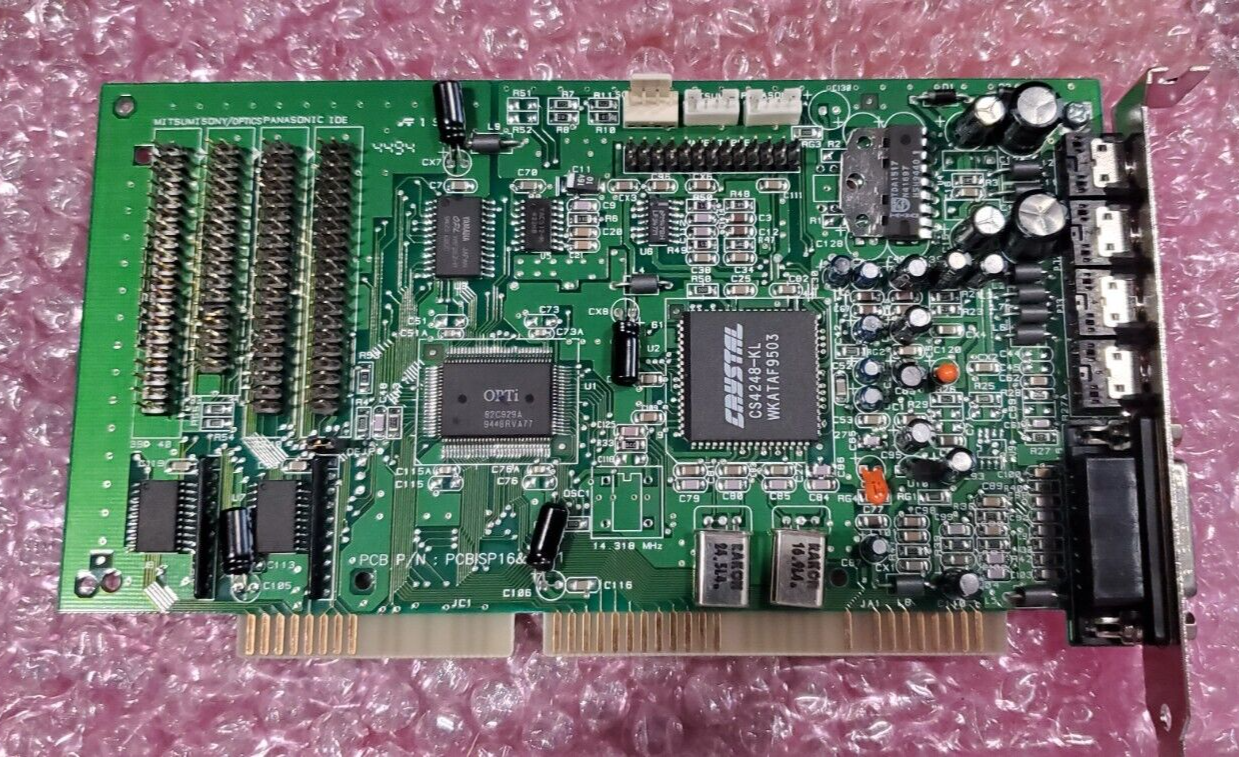  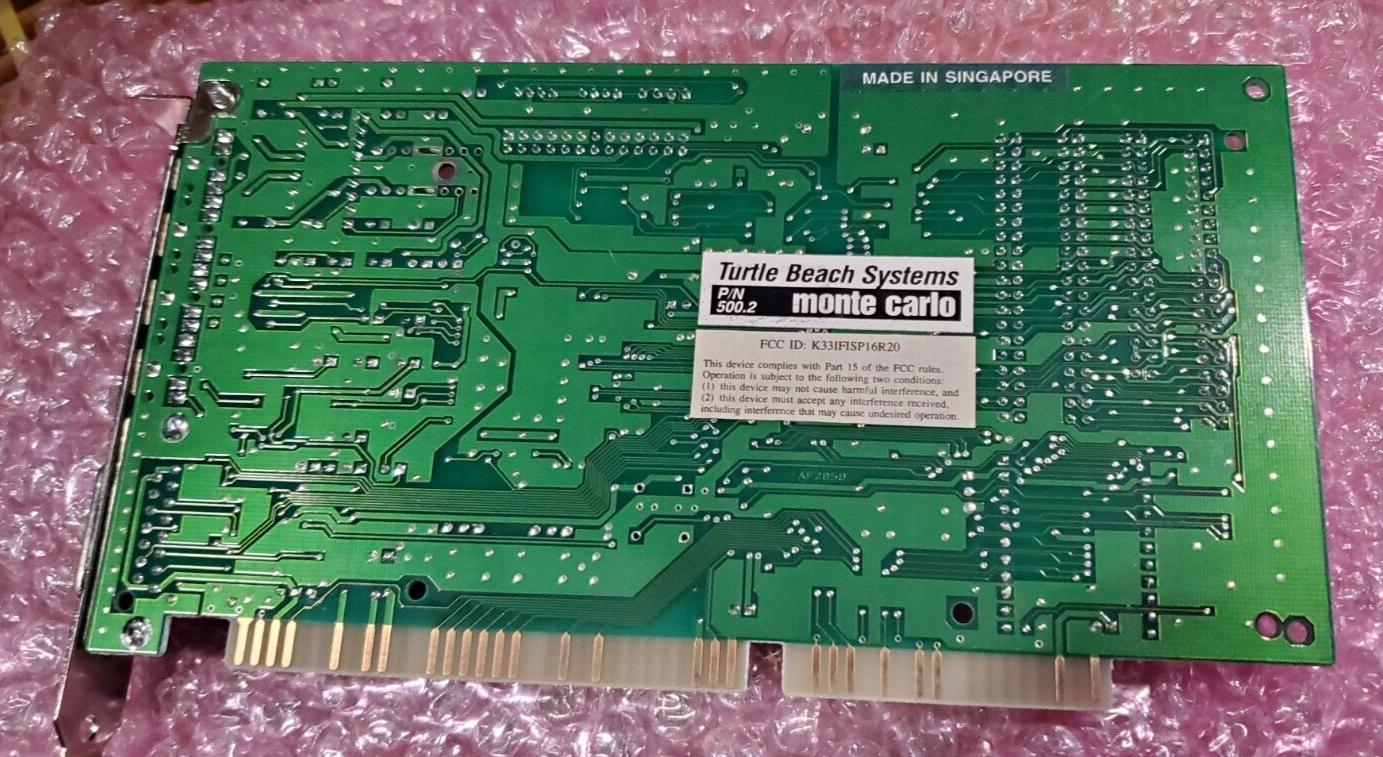 
|
MultiSound Pinnacle  
Introduced: 1996
Synthesizer: Kurzweil MA-1
Chipset/DSP: Motorola DSP56002
Memory: 2 MB ROM (compressed from 4 MB), with slots to support up to 48 MB RAM max.
DAC: 20-bit
Bus: 16-bit ISA
Price when New: ?
Known Board Revisions: D, F
(see pic above)
The Pinnacle is the top of the range of the third-generation of MultiSound cards from Turtle Beach. In December 1996 ICS sold Turtle Beach to Voyetra, and by this stage ICS were no longer marketing the WaveFront, which again left TB without a synth chip. They turned to Kurzweil and struck a deal to use their incredible MA-1 on the 3rd-gen MultiSound Pinnacle.
At its heart is a Motorola 56002 DSP chip (also used by the TB Multisound Fiji), which runs at 40 MHz. The Kurzweil MA-1 is General MIDI-compatible, and contains 128 instruments, 16 channels and 32 voices, plus reverb and chorus effects for each MIDI channel built-in.
The Pinnacle also gets a WaveBlaster-compatible wavetable header which is designed to work with the Kurzweil HOMAC daughterboard (sold separately) which would then act as a second synth engine. These were also bundled together and sold as the Pinnacle Project Studio.
The two 32-bit RAM slots support FPM (Fast Page Mode) SIMM modules only, and the game/MIDI port is MPU-401 (UART) compatible.
The card also comes with an EIDE header for CD-ROM connectivity.
As you would expect from Turtle Beach, the signal-to-noise ratio on these Multisound cards is excellent, -97 dB. In playback [digital-to-analogue] tests conducted by PCAVTech, it got a Signal-to-Noise ratio of -88dB - this is considered very good. |
Malibu / Malibu Surround 64        
Launched: 1996 / 1997
Synthesizer/DSP: Kurzweil MA-1 plus software synth
Chipset: Crystal CS4237B
DAC: -
Memory: 2 MB ROM (4 MB patch set compressed to 2 MB)
Bus: 16-bit ISA
Part No.: TB400-0550-01
FCC ID: JMN-TBS-0550
Known Board Revisions: C
The Malibu, with its Crystal CS4237B sound chip, was a Plug & Play card compatible with Ad Lib (OPL2 and OPL3), Sound Blaster Pro, Sound Blaster 16 and Windows Sound System standards.
For MIDI, it got the same hardware wavetable chips as the Kurzweil HOMAC daughterboard, but also got a software synthesizer for use in Windows called "WaveStream".
Ports on the side are Line In, Line Out, Mic, and S/PDIF out.
Using the Crystal utility, CS4232C.EXE, this card's General MIDI capability can be used in a DOS environment - you just need to be sure to use v2.01 T3 (in the link above) of the drivers.
The Malibu Surround 64, launched in 1997, added SRS surround sound to the base Malibu model. It was their last ISA sound card.
In playback [digital-to-analogue] tests conducted by PCAVTech, it got a Signal-to-Noise ratio of -78dB - this is considered very good.
|
 Fiji Fiji  
Launched: 1996
Synthesizer/DSP: Motorola DSP56002
Chipset: Xilinx XC5210
DAC: -
Bus: 16-bit ISA
Wavetable Header: Yes
Part No.: -
FCC ID: -
Known Board Revisions: B1
Fiji was the budget version of the 3rd generation Pinnacle from Turtle Beach. Fiji was identical to the Pinnacle except it did not come with an onboard wavetable nor the EIDE header for a CD-ROM.
In playback [digital-to-analogue] tests conducted by PCAVTech, it got a Signal-to-Noise ratio of -93dB - this is considered excellent.
  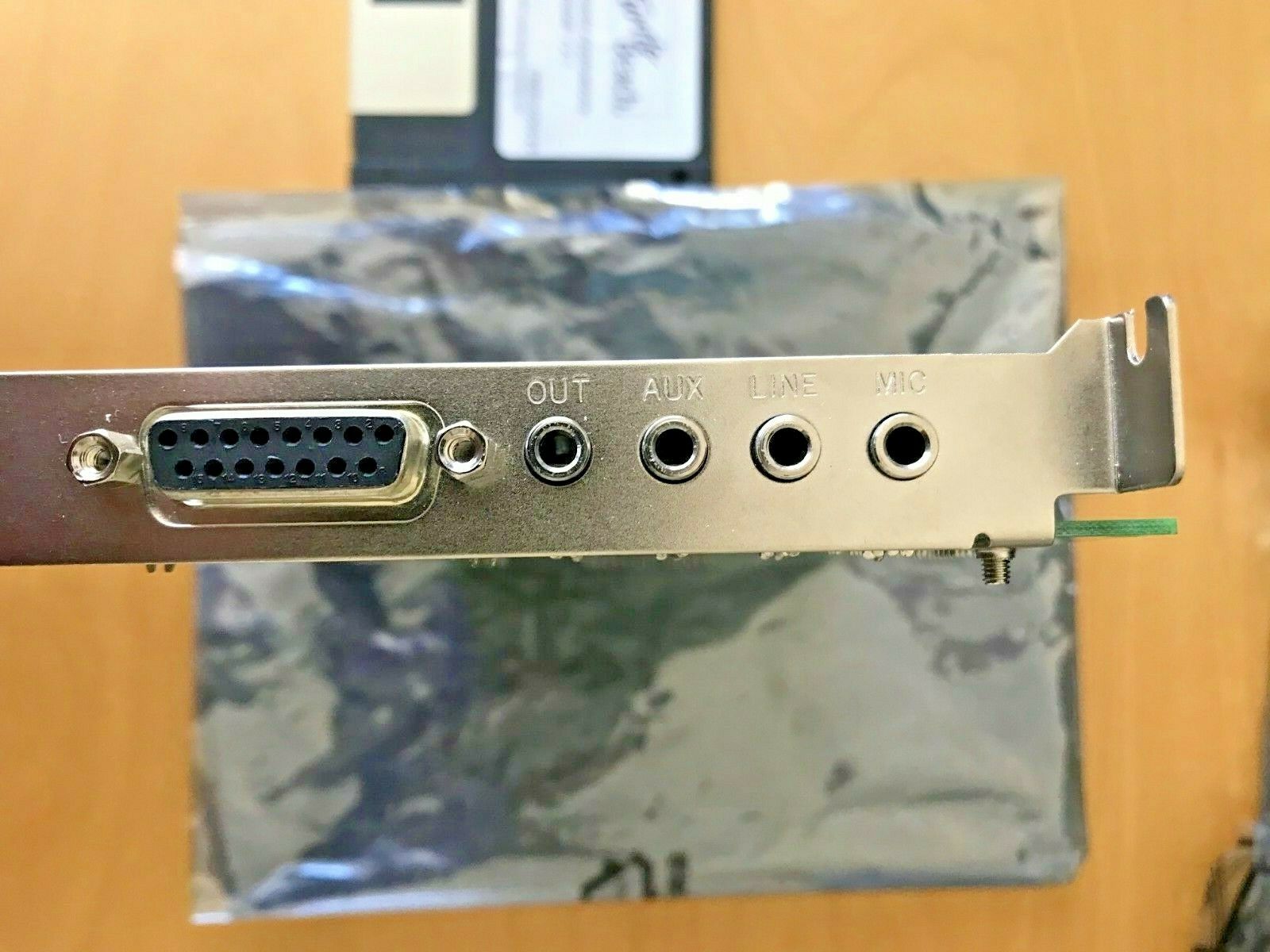 
|
 Daytona Daytona       
Launched: November 1997
FM synthesizer: "S3FM" OPL3 clone (embedded)
Chipset: S3 86C617 "Sonic Vibes"
Bus: PCI
Price When New: $40
Part #s: TB400-0660-01, TB400-0660-01V
(Turtle Beach Daytona)
FCC ID: M4CS0040
Widely regarded as the very first PCI sound card on the market. See the S3 page for more details and drivers for this wavetable and FM synth chip.
The Daytona came with the optional 32Kx8 SRAM chip for reverb effects.
The Daytona came bundled with MIDISOFT's Internet Kit, Internet Audio Postcard v1.0, MediaPlayer, and a Voyetra audio player, plus utilities. |
 Montego I Montego I       
Launched: 1997
FM synthesizer: (embedded in Vortex)
Chipset: Aureal Vortex
Bus: PCI
Price when New: ?
The budget Montego card was sold to numerous OEMs including Dell and IBM. Dell bundled it in their Optiplex GX1P Pentium III 500 MHz system in 1999.
|
Montego II        
Launched: May 1998
FM synthesizer: (embedded in Vortex 2)
Chipset: Aureal Vortex 2
Bus: PCI
Price when New: ?
The Montego II was one of the first cards to support Aureal's A3D 2.0 API. |


.png)


.png)















